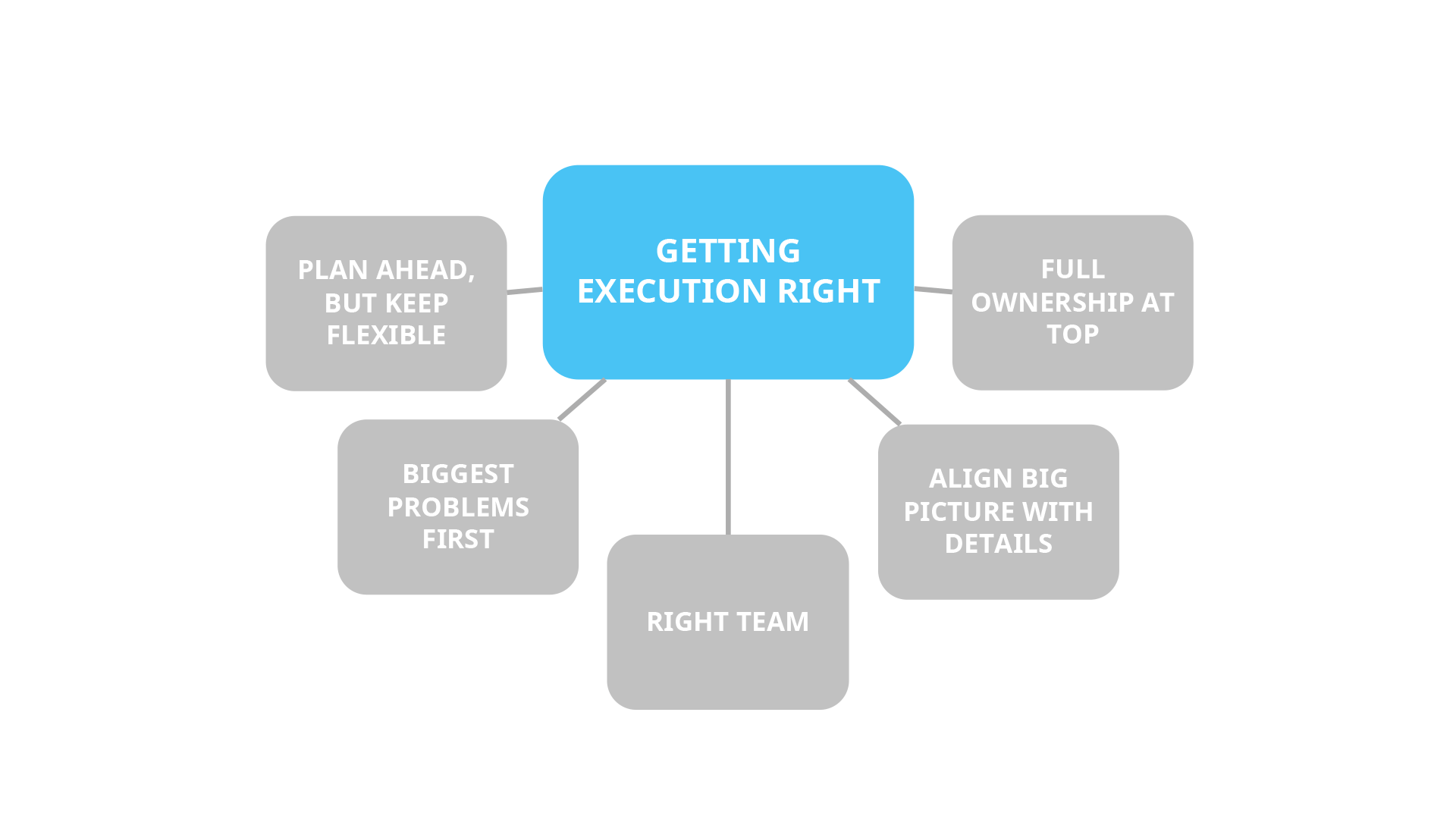The Leader’s Guide to Executing Innovation
Many would-be innovators obsess over ideas, wait for inspiration to strike, and believe that with the right idea, success can miraculously come overnight.
However, as we’ve written before, that’s just not going to happen. In fact, usually the only thing separating the winning innovators from the rest is execution. It makes all the difference in the world, and yet, it’s still a vastly underrated capability.
As part of our coaching program, we’ve asked hundreds of corporate innovators and innovation leaders to reflect on their strengths and weaknesses. And, by far, the most common answer is that they’re great at coming up with ideas and thinking about the big picture but lack the patience and discipline to see things through to results.
As such, it’s safe to say that as a community, we innovators need to take a hard look in the mirror and admit that this an area where most of us have a lot of room for improvement.
So, in today’s article, we’ll explore the topic of executing innovation in more detail to try to understand what the problems associated with it are, and what successful execution of an innovation really takes. This is designed to be a guide to help leaders get it right, but I think there’s a lot that every innovator regardless of job title can learn from.
Table of contents
What does executing innovation mean?
Before we dive deeper, it’s probably a good idea to clarify what we mean with the term “executing innovation”, and how it relates to “implementing innovation”.
These are often used interchangeably, but I think it’s useful to distinguish them from one another. The way we like to put this is as follows:
Implementing innovation is the process of taking an idea and then turning that into reality.
Executing innovation, on the other hand, is the entire process of creating value with innovation.
In other words, implementation is what you do for an individual idea to make that happen. Execution covers the implementation, but also the process of turning that (along with many other ideas and innovations) into something that actually creates value and can be scaled up.
Implementation isn’t always easy, but it’s still typically a linear project that you can usually plan out in advance. Execution, on the other hand, is a much more complex and multidisciplinary effort. To succeed at delivering value, you need to get a lot of things right. And with innovation, there are many assumptions in that plan. Some of those assumptions will always prove to be false, and you’ll need to deviate from the plan.
To succeed at delivering value, you need to get a lot of things right. And with innovation, there are many assumptions in that plan. Some of those assumptions will always prove to be false, and you’ll need to deviate from the plan.
That combination of multidisciplinary collaboration and the need to deviate from original plans often leads to a myriad of practical challenges in many large organizations.
However, before we dive deeper into those challenges, let’s first take a step back to realize why execution is so critical.
Why execution is critical for innovation success
There’s a reason for innovation being defined as the act of introducing something new.
Everyone has ideas. Many can even implement some form of them, typically a prototype, but few successfully realize the full potential of the idea by truly executing on it successfully.
To clarify, ideas are an important starting point, but with every great idea, there are hundreds or even thousands of people across the world who’ve had the same exact idea.
Most never start working on it. Many give up in the process. Some make it to market, and a few might even make that into a feasible business. There are usually only a couple of winners. Those are the ones that succeeded in executing that idea.
Everyone has ideas, but few successfully realize the full potential of their ideas. The ones that do are the ones that know how to execute well.
This is of course a bit of an oversimplification but should help explain the fundamental importance of proper execution.
And that is not just true for individual ideas and innovations, but it’s also the case for corporate strategies at large. Look at any given industry, and it’s quite likely that you’ll see many companies with a nearly identical strategy. Again, the difference comes down to how well the company succeeded in executing that strategy.
In other words, your idea or strategy sets the ceiling for your impact if successful, but execution determines how close to that ceiling you’ll get. Even the best idea or strategy is worth nothing unless it’s executed well.
On the other hand, even with a mediocre strategy or idea, you can achieve remarkable success if you just execute it well enough. There are dozens of well-known companies like McDonald’s and FedEx that are obvious examples of this. There’s nothing particularly remarkable or distinctive about their ideas or strategies. They weren’t the first in their respective fields, they just executed on their ideas brilliantly. What’s more, if you’re a strong executor, you’ll soon find out the limits of the original strategy or idea, at which point you can adapt and change course accordingly. But, it doesn’t work the other way around.
What’s more, if you’re a strong executor, you’ll soon find out the limits of the original strategy or idea, at which point you can adapt and change course accordingly. But, it doesn’t work the other way around.
Thus, no matter the situation, execution will always be more important than your idea or strategy.
Misconceptions about executing innovation
As you might have realized by now, execution is of course a massive, nuanced, context-specific and very complex endeavor. In practice, it’s an endless jungle of interlinked choices and actions affecting one another that you need to navigate with limited information to get to the other side.
Thus, the space of possible challenges and problems you might encounter is pretty extensive. So, instead of looking at the individual problems themselves, it’s more helpful for us to try to understand the common misconceptions that ultimately lead to teams underappreciating execution and thus subsequently failing at it.
A big factor behind most of these is the fundamental uncertainty that innovation is always associated with. Because you can’t know everything in advance, it’s not going to be a nice and linear process of doing simple steps one after another. Instead, it’s a messy and iterative process of creative problem-solving.
Anyway, with that, here are the top four that I most commonly see innovation leaders and their teams have.
1. The leader’s job is just to get the big picture right
This is probably the most common problem I’ve come across, and it’s especially common among inexperienced executives, or ones that otherwise lack execution experience, such as some management consultants and academics.
There are many shapes this one might take, and we’ll return to it later, but what it ultimately comes down to is the glorification of strategy work and/or surface-level creativity.
In business school, and in consulting, we’re taught to think about the big picture as the job of top management. We’re led to believe that a leader or innovator takes in a market analysis, compares a few scenarios, chooses a positioning, and then paints an inspiring vision to show direction for the company. Then the pieces will simply fall in place and success happens. While the above mentioned are of course still useful activities, if you’ve ever actually turned an innovative idea into a successful business, you know that in practice, there’s a lot more to it than that, and experienced executives are of course well aware of that
While the above mentioned are of course still useful activities, if you’ve ever actually turned an innovative idea into a successful business, you know that in practice, there’s a lot more to it than that, and experienced executives are of course well aware of that
Strategic choices can be made across the organization, but the responsibility for execution always lies at the top.
As Professor Martin has well put it, CEOs should stop thinking that execution is somebody else’s job, and the same applies for every innovation leader. Strategic choices can be, and frequently are, made where the action is. Yet, the responsibility for execution always lies at the top. After all, there’s a reason for the CEO being the Chief Executive Officer.
2. I don’t need to understand the details
The second is closely related to our first one. It’s easy to think that as a leader or visionary innovator, you’re the person responsible for the vision, ideas, and big picture decisions, and then the experts will then figure things out in practice. After all, that’s why you hired them, right?
Well, that might work if you’re operating in a static industry where all the variables are known and static, but with innovation that really isn’t the case.
You need to get the big picture right, but it isn’t enough to succeed. You need to also have the right product, business model, technology, customer experience, customer acquisition channels and tactics, operating models, etc. All of these have a wide variety of choices that depend on one another and changes in any of the areas will force you to change many of the other pieces in the puzzle too.
With innovation, the devil is in the details!
As an innovation leader, connecting the dots is ultimately your job, and you can’t do that without understanding the details.
That’s why you’ll find an obsession for the details in pretty much every successful innovator, both past and present. They have the same in-depth understanding and attention to detail as the best artists, athletes and top representatives of other fields do too.
So, while you absolutely need to engage with and empower the experts, they are experts in their own field and likely don’t know how to consider all the other moving pieces in the puzzle. As an innovation leader, connecting the dots is ultimately your job, and you can’t do that without understanding the details.
It’s the one responsibility you simply can’t delegate away.
3. Execution requires a clear and unambiguous plan
Even if you are an experienced executive and value the importance of execution highly, it doesn’t mean you couldn’t fail when executing innovation. Here the most common problems occur if the leader’s experience comes primarily from operations within the known and well understood confines of “business as usual”.
When the environment is well understood, and the scale large from the get-go, it’s of course valuable to try to plan carefully, analyze business cases and craft detailed project plans prior to execution.
Also, since everyone knows that innovation is a risky endeavor, it of course makes sense to try to reduce those risks before your start a big innovation project to try to avoid major mistakes and generally just ensure that you’ve done a good job in planning and preparation before committing to the project.
This often leads to large companies commissioning all kinds of market studies and strategy projects. Some of those can certainly be useful in increasing your understanding of the landscape, but most invest way too much time, energy, and money into these. Also, every now and then these projects seem to be ordered only to have a scapegoat in case something goes wrong.
Regardless, there’s a fundamental problem: with innovation, you can’t have all the answers in advance. You’ll always need to make a number of assumptions upon which your plan relies on, some of which will inevitably prove to be wrong.
With innovation, you won't have all the answers in advance.
Thus, if you require innovators to propose clear, detailed and unambiguous plans for you, or conversely create such plans and then hold innovators accountable for successfully executing them, it just won’t work out. And, whenever it then comes to surface that everything hasn’t gone according to the plan, innovation projects are frequently shut down, even if they'd still hold a lot of potential.
You obviously still need to align with the strategy, plan ahead, and have a disciplined approach to execution, but it’s not so much about creating a detailed roadmap, as it is about choosing direction and figuring out which questions or problems you’ll need to address first.
In other words, you need to embrace the uncertainty and the fact that you can’t have a perfectly unambiguous and detailed plan before starting to execute it. Instead, figure out what the assumptions and uncertainties in your plan are and commit to a disciplined learning effort to figure out the right path forward.
4. Innovation is fun
There’s a stereotype around people working in innovation being these visionaries that are bursting with great ideas and seem to come up with great new concepts all the time. And as mentioned in the intro to this article, that is often true. That skillset is of course very useful for innovation, but there’s also a downside. There are naturally exceptions, but many of us working on innovation can find execution too boring and repetitive, and/or lack the perseverance, discipline, and patience needed to succeed at it.
That skillset is of course very useful for innovation, but there’s also a downside. There are naturally exceptions, but many of us working on innovation can find execution too boring and repetitive, and/or lack the perseverance, discipline, and patience needed to succeed at it.
Innovators often spend too much on the creative and “fun parts” of innovation, as opposed to what’s really needed to turn an idea into a successful innovation
As a group, we generally love creative work, and are always looking for fresh, new stimuli to feed that inspiration. That often leads us to spend too much time and effort on the “fun parts” of innovation, and too little on the not so fun, more repetitive, and laborious parts of the process that execution essentially is comprised of.
The reality is that for every minute you spend coming up with ideas, you'll probably need to spend a day, a week, or even more implementing those ideas.
So, if your innovation team is primarily filled with, or led by, such “idea people”, which is quite common, then there’s a big risk of a systematic lack of respect for and capabilities in execution. This will lead to a very suboptimal culture for innovation, and ultimately disappointing business outcomes.
Getting Execution Right
As already mentioned, there are a lot of similarities between successful execution in “business as usual”, and in innovation. However, there are also clear differences between the two.
So, to help you navigate the differences, and to succeed at executing on whatever innovation you’re working on, here are the five most important factors to keep in mind whenever you’re trying to execute on an innovation and build something truly novel.

1. Take the path most likely to succeed, but keep your options open
As mentioned, with innovation planning and strategy work need to be done a bit differently than you would with an existing business.
Good decisions here make it much easier for your team to figure out how to move forward and can save a lot of time money going down the wrong path. Regardless, you’ll soon end up at another crossroads and need to make another decision. Heck, sometimes you might even come across a dead-end and need to backtrack to an earlier crossroads. Sometimes Plan C or D is the way to go. The point is that no matter which path you choose, you won’t see what’s ahead all the way to the end.
The point is that no matter which path you choose, you won’t see what’s ahead all the way to the end.
Thus, good strategy work requires you to embrace uncertainty, test assumptions critically, and think deeply about the real-life feasibility of each path ahead.
And it’s certainly not a one-time project you do at the beginning, but more of a continuous learning process as you unravel the puzzle piece by piece.
If you keep an open mind and build your teams and products to embrace that uncertainty, you can quickly recover and learn from setbacks, as well as embrace new opportunities you couldn’t even think of before you set out. This is what’s known as cognitive and organizational flexibility.
2. Solve the biggest problems first
As humans, most of us have a bit of a tendency to go for the comfortable low-hanging fruits and procrastinate on the hard but important problems, as well as uncomfortable truths.
I’ve certainly been guilty of this on many occasions, even while writing of this article. Getting a number of small things done makes us feel like we’re making good progress, but unfortunately that’s often a bit of a false sensation as we might not really be any better off than when we began.
With the inherit uncertainty in innovation, that is naturally a bit of a problem. When you’re executing any given innovation, there’s countless things that need to be done so it’s easy to just start checking off boxes like building more features, creating marketing materials, getting compliance approvals, or whatever you may have on your agenda.
But, it’s the big things that make or break your innovation early on. For example: will a customer benefit from my product, how much are they willing to pay, can I even build the product I’ve envisioned, etc.
While you need to care about the details, it's the big things that make or break your innovation early on. So, start from the big problems, even if it hurts!
The key is finding a way to figure out what these big problems or critical assumptions are, and then find ways to quickly test and address them. This allows you to quickly figure out if you’re on to something, which of course saves a lot of time and money for you in the inevitable case that you weren’t quite there from the get-go.
Also, if you get the big things right, you can already deliver most of the value, and that means you can more quickly start capturing some of that value to get a return for your investments.
Plus, if you tackle these early on when you still have a small team, changing course will be much quicker and easier, and you’ll have spent much less money solving the same important problems than you would with a larger team later on.
In most businesses, these critical assumptions revolve around how much value you can deliver to customers, and how valuable they see that to be. However, in certain circumstances, those can be related to something entirely different, such as the feasibility of implementation when developing a new breakthrough drug.
Solving for the hardest problems first does generally require a bit more of a leadership commitment as you won’t always be able to show quick wins as early on, but at least it can save you from an embarrassing and costly failure like CNN+.
3. Build the right team
It might be a bit of an obvious statement, but it’s still probably worth pointing out: innovation is a bit of a team sport. So, to do well at it, you need the right team.
However, what might not be as obvious is that ‘the right team’ means in practice. In our experience, there are two key parts to this:
- Multidisciplinary team with talented individuals in each area
- Leadership and individuals that share the right mindset for innovation
The prior is pretty self-explanatory. Innovation is almost always a cross-disciplinary effort. The specifics depend on what kind of an innovation you’re working on, but usually you need expertise in at least design, engineering, commercial and operational matters.
The most impactful innovations are actually comprised of a stack of innovations in many of these areas, each designed to work together to address a specific problem or ‘job’ for the customer. Thus, if you have talent at every position, the outcome will be much more than the sum of its parts. The latter, however, is the part that many teams fail to appreciate. Innovation is, by definition, doing something that others haven’t succeeded at before, so the journey won’t be easy.
The latter, however, is the part that many teams fail to appreciate. Innovation is, by definition, doing something that others haven’t succeeded at before, so the journey won’t be easy.
Your team will face a lot of uncertainty and struggles, and will still need to perform at their best, often under a lot of pressure. That requires a very specific type of culture within the team, but also the right mindset for each individual. You want people that can cope with uncertainty and are able to remain optimistic and overcome difficult situations while still being realistic and ruthlessly critical of their own capabilities. They need to have an innate passion to strive for excellence, and a lot of discipline, grit, and perseverance.
And, of course, because it’s a team sport, people need to be able to work well together and perform as a team. This, however, isn’t usually much of an issue as long as people can leave their egos at the door. The struggles you will face together as a team will build bonds and gel you into a team.
4. Make sure every decision and detail are aligned
As we already discussed, you don’t need (and usually can’t have) a clear and unambiguous plan for an innovation project where every role and task would be charted out in advance. However, as we also discussed, the devil is often in the details and seemingly small things can derail the project from its goals?
So, what gives?
Well, the point is that with innovation, you need to keep an eye on everything. As an innovation leader, you need to maintain excellent awareness of both the big picture and the details throughout the project. But, because the environment changes dynamically and you need to move fast, you can’t really do that work upfront.
Nor can you just look at some KPIs and financial reports to figure out if things are moving in the right direction because the important things won’t show up in these for quite a while, and at that point, it’s often too already too late to react. As a leader, your primary job is to keep up with what’s going on both with the ever-changing big picture, and the details on the ground so that you can spot problems early and intervene before it’s too late, no matter where the issues might arise from. If you don’t understand how everything works in practice and know what problems everyone is working on and why, it will be pretty much impossible to do that.
As a leader, your primary job is to keep up with what’s going on both with the ever-changing big picture, and the details on the ground so that you can spot problems early and intervene before it’s too late, no matter where the issues might arise from. If you don’t understand how everything works in practice and know what problems everyone is working on and why, it will be pretty much impossible to do that.
Some might see the latter as micro-management, but it doesn't mean you have to dictate what everyone does. It just means that as a leader, you need to be the person that connects the dots and then empowers the team to succeed. There's a clear difference.
Which brings us nicely to our last point.
5. Take full ownership for the execution
As we’ve covered, execution is the make-or-break part in the lifecycle for every innovation.
It’s always a bit of an exploratory process where you need to remain flexible, while still moving forward quickly and executing at a high level.
And, at the same time, seemingly inconsequential low-level choices related to implementation turn out to become existential issues for any innovation project.
Again, you don’t need to decide everything on behalf of your team. In fact, often it’s best to let the experts solve problems and do their job, as long as you can give them the right guidance and constraints to work with. Instead, you need to think of every potential problem as your fault and then figure out a way to get past them together with your team.
The bottom line is that being an innovation leader isn’t easy. It takes a lot of time and work to understand and stay on top of things, but as already mentioned, that's the one thing you can't really skip, automate, or delegate. Essentially everything else you can.
The only way to succeed at that is to take full ownership and commit to the process.
Conclusion
We’ve covered a lot of ground, so let’s do a bit of a recap.
Innovation isn’t a linear project that you can plan out in advance and monitor progress with a Gantt chart. There will always be plenty of surprises. Many unpleasant, but usually some positive ones too. You’ll need to be flexible enough to react to these and alter course accordingly.
It’s an inherently messy and iterative process of figuring out a way to build new things and align all the pieces so that everything works out.
Fundamentally, an innovation leader’s job is to show direction and try to keep track of everything that’s happening, align those puzzle pieces together with the big picture while always being on the lookout for potential problems and then eliminate those before they derail the project, as there will be many.
It’s not an easy or comfortable job, but if you can get it right, it’s an incredibly rewarding one.
Ironically, despite all the talk about practical issues and attention to detail being vital, this has been a bit of a high-level overview on the topic. So, if you’re interested in learning more about the details related to what we’ve discussed today, I have a couple of practical recommendations for you:
First, the best way to learn to innovate is by doing. So, get your hands dirty, keep these tips in mind, do your best, and I’ll guarantee you’ll learn a lot.
But, if you currently don’t quite have the time to commit to an innovation project, a good alternative way to learn more about innovation management is with our Innovation System online coaching program. We’ve now made the program completely free of charge for the first 1000 readers to sign up for it.
Best of luck with your innovation efforts!





